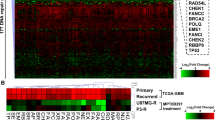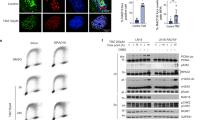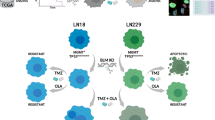Abstract
Malignant gliomas, the deadliest of brain neoplasms, show rampant genetic instability and resistance to genotoxic therapies, implicating potentially aberrant DNA damage response (DDR) in glioma pathogenesis and treatment failure. Here, we report on gross, aberrant constitutive activation of DNA damage signalling in low- and high-grade human gliomas, and analyze the sources of such endogenous genotoxic stress. Based on analyses of human glioblastoma multiforme (GBM) cell lines, normal astrocytes and clinical specimens from grade II astrocytomas (n=41) and grade IV GBM (n=60), we conclude that the DDR machinery is constitutively activated in gliomas, as documented by phosphorylated histone H2AX (γH2AX), activation of the ATM-Chk2-p53 pathway, 53BP1 foci and other markers. Oxidative DNA damage (8-oxoguanine) was high in some GBM cell lines and many GBM tumors, while it was low in normal brain and grade II astrocytomas, despite the degree of DDR activation was higher in grade II tumors. Markers indicative of ongoing DNA replication stress (Chk1 activation, Rad17 phosphorylation, replication protein A foci and single-stranded DNA) were present in GBM cells under high- or low-oxygen culture conditions and in clinical specimens of both low- and high-grade tumors. The observed global checkpoint signaling, in contrast to only focal areas of overabundant p53 (indicative of p53 mutation) in grade II astrocytomas, are consistent with DDR activation being an early event in gliomagenesis, initially limiting cell proliferation (low Ki-67 index) and selecting for mutations of p53 and likely other genes that allow escape (higher Ki-67 index) from the checkpoint and facilitate tumor progression. Overall, these results support the potential role of the DDR machinery as a barrier to gliomagenesis and indicate that replication stress, rather than oxidative stress, fuels the DNA damage signalling in early stages of astrocytoma development.
This is a preview of subscription content, access via your institution
Access options
Subscribe to this journal
Receive 50 print issues and online access
$259.00 per year
only $5.18 per issue
Buy this article
- Purchase on Springer Link
- Instant access to full article PDF
Prices may be subject to local taxes which are calculated during checkout




Similar content being viewed by others
References
Bao S, Wu Q, McLendon RE, Hao Y, Shi Q, Hjelmeland AB et al. (2006). Glioma stem cells promote radio resistance by preferential activation of the DNA damage response. Nature 444: 756–760.
Bartek J, Bartkova J, Lukas J . (2007). DNA damage signaling guards against activated oncogenes and tumour progression. Oncogene 26: 7773–7779.
Bartkova J, Bakkenist CJ, Rajpert-De Meyts E, Skakkebaek NE, Sehested M, Lukas J et al. (2005a). ATM activation in normal human tissues and testicular cancer. Cell Cycle 4: 838–845.
Bartkova J, Horejsi Z, Koed K, Krämer A, Tort F, Zieger K et al. (2005b). DNA damage response as a candidate anti-cancer barrier in early human tumorigenesis. Nature 434: 864–870.
Bartkova J, Horejsi Z, Sehested M, Nesland JM, Rajpert-De Meyts E, Skakebaek NE et al. (2007). DNA damage response mediators MDC1 and 53 BP1: constitutive activation and aberrant loss in breast and lung cancer, but not in testicular germ cell tumours. Oncogene 26: 7414–7422.
Bartkova J, Rezaei N, Liontos M, Karakaidos P, Kletsas D, Issaeva LV et al. (2006). Oncogene-induced senescence is part of the tumorigenesis barrier imposed by DNA damage checkpoints. Nature 444: 633–637.
Bekker-Jensen S, Lukas C, Melander F, Bartek J, Lukas J . (2005). Dynamic assembly and sustained retention of 53BP1 at the sites of DNA damage are controlled by Mdc1/NFBD1. J Cell Biol 170: 201–211.
Bonner WM, Redon CE, Dickey JS, Nakamura AJ, Sedelnikova OA, Solier S et al. (2008). H2AX and cancer. Nat Rev Cancer 8: 957–967.
Bristow RG, Hill RP . (2008). Hypoxia and metabolism. Hypoxia, DNA repair and genetic instability. Nat Rev Cancer 8: 180–192.
Cimprich KA, Cortez D . (2008). ATR: An essential regulator of genome integrity. Nat Rev Mol Cell Biol 9: 616–627.
Di Micco R, Fumagalli M, Cicalese A, Piccinin S, Gasparini P, Luise C et al. (2006). Oncogene-induced senescence is a DNA damage response triggered by DNA hyper-replication. Nature 444: 638–642.
DiTullio RA, Mochan TA, Venere M, Bartkova J, Sehested M, Bartek J et al. (2002). 53BP1 functions in an ATM-dependent checkpoint pathway that is constitutively activated in human cancer. Nat Cell Biol 4: 998–1002.
Dungey FA, Caldecott KW, Chalmers AJ . (2009). Enhanced radiosensitization of human glioma cells by combining inhibition of poly(ADP-ribose) polymerase with inhibition of heat shock protein 90. Mol Cancer Ther 8: 2243–2254.
Furnari FB, Fenton T, Bachoo RM, Mukasa A, Stommel JM, Stegh A et al. (2007). Malignant astrocytic glioma; genetics, biology and paths to treatment. Genes & Dev 21: 2683–2710.
Gorgoulis VG, Vassiliou LV, Karakaidos P, Zacharatos P, Kotsinas A, Liliglou T et al. (2005). Activation of the DNA damage checkpoint and genomic instability in human precancerous lesions. Nature 434: 907–913.
Halazonetis TD, Gorgoulis VG, Bartek J . (2008). An oncogene-induced DNA damage model for cancer development. Science 319: 1352–1355.
Helleday T, Petermann E, Lundin C, Hodgson B, Sharma RA . (2008). DNA repair pathways as targets for cancer therapy. Nat Rev Cancer 8: 193–204.
Jackson SP, Bartek J . (2009). The DNA-damage response in human biology and disease. Nature 461: 1071–1078.
Knizetova P, Ehrmann J, Hlobilkova A, Vancova I, Kalita O, Kolar Z et al. (2008). Autocrine regulation of glioblastoma cell cycle progression, viability and radiorestance through the VEGF-VEGFR2 (KDR) interplay. Cell Cycle 7: 2553–2561.
Li D, Marks JD, Schumacker PT, Young RM, Brorson JR . (2005). Physiological hypoxia promotes survival of cultured cortical neurons. Eur J Neurosci 6: 1319–1326.
Luo J, Solimini NL, Elledge SJ . (2009). Principles of cancer therapy: oncogene and non-oncogene addiction. Cell 6: 823–837.
Malette FA, Ferbeyre G . (2007). The DNA damage signaling pathway connects oncogenis stress to cellular senescence. Cell Cycle 6: 1831–1836.
Martin SA, Lord CJ, Ashworth A . (2008). DNA repair deficiency as a terapeutic target in cancer. Curr Opin Genet Dev 18: 80–86.
Mistrik M, Oplustilova L, Lukas J, Bartek J . (2009). Low-dose DNA damage and replications stress responses quantified by optimized automated single-cell image analysis. Cell Cycle 8: 2592–2599.
Mukherjee B, McEllin B, Camacho CV, Tomimatsu N, Sirasanagandala S, Nannepaga S et al. (2009). EGFRvIII and DNA double-strand break repair: A molecular mechanism for radioresistance in glioblastoma. Cancer Res 69: 4252–4259.
Nuciforo PG, Luise C, Capra M, Pelosi G, d'Adda di Fagagna F . (2007). Complex engagement of DNA-damage response pathways in human cancer and in lung tumor progression. Carcinogenesis 28: 2082–2088.
Raderschall E, Golub EI, Haaf T . (1999). Nuclear foci of mammalian recombination proteins are located at single-stranded DNA regions formed after DNA damage. Pro Natl Acad Sci USA 96: 1921–1926.
The Cancer Genome Atlas Research Network (2008). Comprehensive genomic characterization defines human glioblastoma genes and core pathways. Nature 455: 1061–1068.
Zheng H, Ying H, Yan H, Kimmelman AC, Hiller DJ, Chen AJ et al. (2008). P53 and Pten control neural and glioma stem/progenitor cell renewal and differentiation. Nature 455: 1129–1134.
Zhou B-BS, Bartek J . (2004). Targetting the checkpoint kinases. Chemosensitization versus chemoprotection. Nat Rev Cancer 4: 216–225.
Acknowledgements
We thank J Darling, University of Wolverhampton and CV Bree, University of Amsterdam for donating the SS859 and Gli-6 cells, respectively and MyungHee Lee for excellent technical assistance. Grant support was obtained from Danish Cancer Society, Danish National Research Foundation, Danish Research Council, Vilhelm Pedersen and Hustrus Mindelegat, Czech Ministry of Education (MSMT6198959216), Grant Agency of the Czech Ministry of Health (NS10282-3/2009), Lundbeck Foundation (R13-A1287) and European Commission (projects: CZ.1.05/2.1.00/01.0030, Active p53, Infla-Care, GENICA).
Author information
Authors and Affiliations
Corresponding authors
Ethics declarations
Competing interests
The authors declare no conflict of interest.
Additional information
Supplementary Information accompanies the paper on the Oncogene website
Supplementary information
Rights and permissions
About this article
Cite this article
Bartkova, J., Hamerlik, P., Stockhausen, MT. et al. Replication stress and oxidative damage contribute to aberrant constitutive activation of DNA damage signalling in human gliomas. Oncogene 29, 5095–5102 (2010). https://doi.org/10.1038/onc.2010.249
Received:
Revised:
Accepted:
Published:
Issue Date:
DOI: https://doi.org/10.1038/onc.2010.249
Keywords
This article is cited by
-
Targeted inhibition of the methyltransferase SETD8 synergizes with the Wee1 inhibitor adavosertib in restraining glioblastoma growth
Cell Death & Disease (2023)
-
The role of nutrition in harnessing the immune system: a potential approach to prevent cancer
Medical Oncology (2022)
-
The DNA Double-Strand Break Repair in Glioma: Molecular Players and Therapeutic Strategies
Molecular Neurobiology (2022)
-
BMI1 nuclear location is critical for RAD51-dependent response to replication stress and drives chemoresistance in breast cancer stem cells
Cell Death & Disease (2022)
-
DNA damage repair in glioblastoma: current perspectives on its role in tumour progression, treatment resistance and PIKKing potential therapeutic targets
Cellular Oncology (2021)



